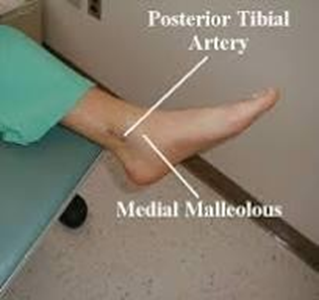A nurse is unable to palpate a client's dorsalis pedis pulse. The nurse will next attempt to palpate the
Carotid pulse
Brachial pulse
Posterior tibialis
Femoral pulse
The Correct Answer is C
A: This is not suitable for assessing circulation issues specifically in the lower extremities as it is located on the upper body.
B: This is not suitable for assessing circulation issues specifically in the lower extremities as it is located on the upper body.
C: Palpating the posterior tibialis pulse is a logical next step for checking lower extremity circulation, particularly when dorsalis pedis is not palpable, helping localize the evaluation of blood flow in the foot and ankle.
D: The femoral pulse is useful for broader leg circulation issues. However, it is less targeted than posterior tibialis for checking blood flow in the lower extremities.

Nursing Test Bank
Naxlex Comprehensive Predictor Exams
Related Questions
Correct Answer is A
Explanation
A: Due to age-related reductions in gastrointestinal muscle efficiency, which slows the digestive process and can lead to increased water absorption from stool.
B: Overstates the issue, not all elderly patients experience difficulties, and it does not account for individual variability or other influencing factors like diet and medication.
C: Misrepresents the frequency and reasons for laxative use among the elderly, not all of whom misuse these medications.
D: While changes in rectal sphincter elasticity can affect some elderly individuals, it is less commonly a direct cause of constipation compared to decreased peristalsis.
Correct Answer is D
Explanation
A: Sonorous wheezes are low-pitched sounds and do not describe fine rales.
B: Musical or whistling sounds typically describe wheezes which are continuous and not the discontinuous sound of rales.
C: Noisy, snoring sounds are characteristic of rhonchi, not rales.
D: Fine rales are high-pitched, brief, and discontinuous crackling sounds that are often likened to the sound of hair being rubbed between fingers, indicative of fluid in the small airways.

Whether you are a student looking to ace your exams or a practicing nurse seeking to enhance your expertise , our nursing education contents will empower you with the confidence and competence to make a difference in the lives of patients and become a respected leader in the healthcare field.
Visit Naxlex, invest in your future and unlock endless possibilities with our unparalleled nursing education contents today
Report Wrong Answer on the Current Question
Do you disagree with the answer? If yes, what is your expected answer? Explain.
Kindly be descriptive with the issue you are facing.
